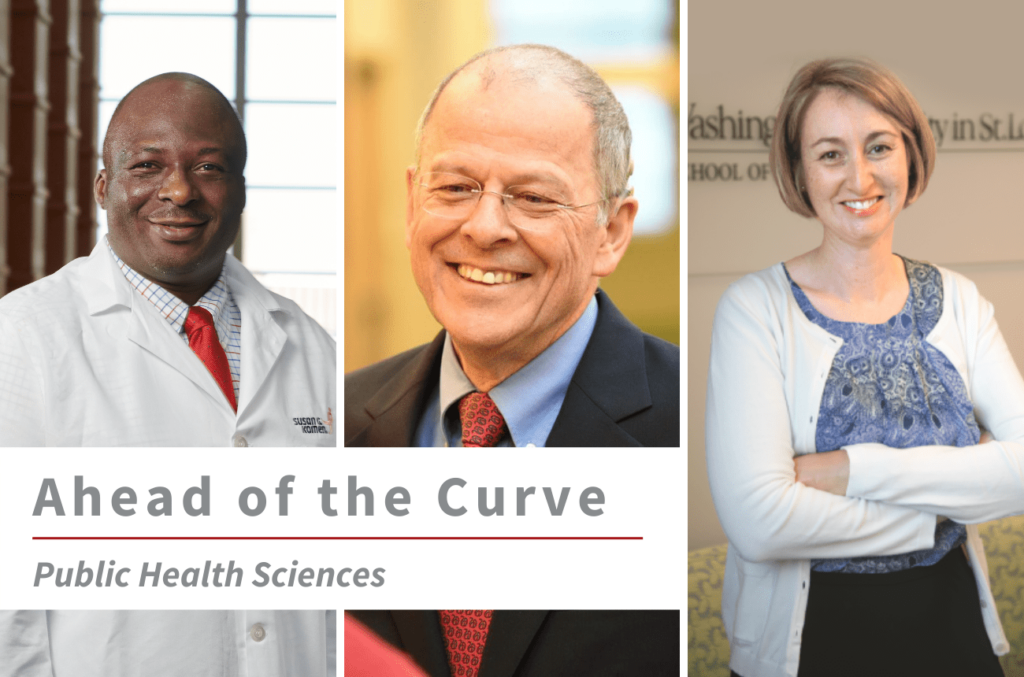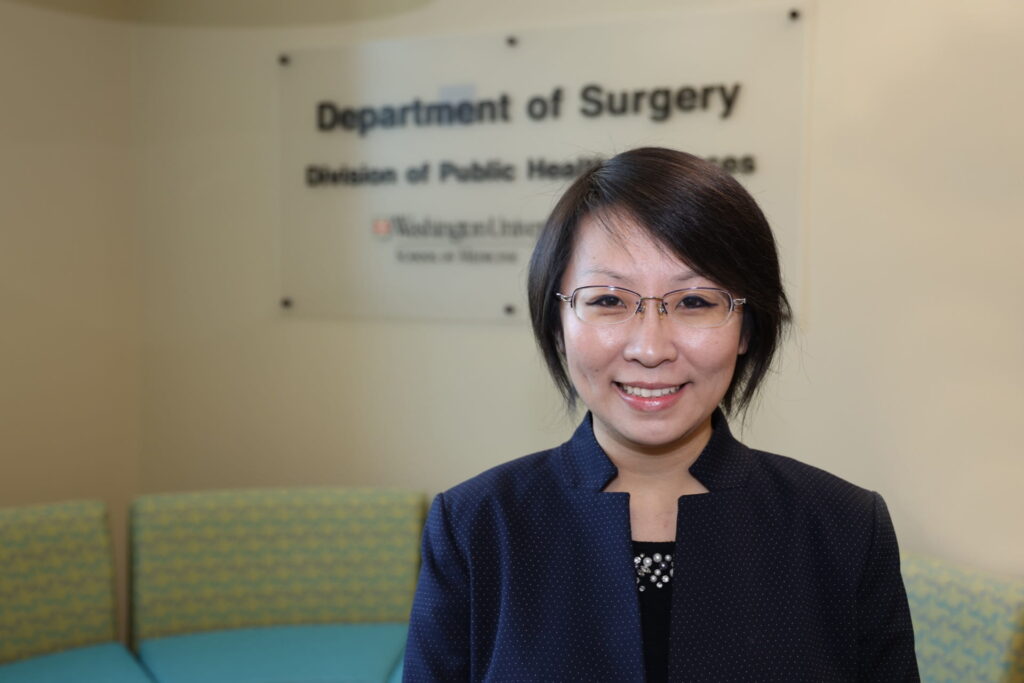The Division of Public Health Sciences provides a platform for investigators
across disciplines to collaborate on projects affecting clinical care and outcomes. Faculty are epidemiologists, statisticians, behavioral scientists, economists, health communication scientists and more. The division leads in public health research, education and outreach, and plays major roles in cancer prevention, reducing community health disparities and improving health care quality and acces. The division offers a Master of Population Health Sciences (MPHS) degree program for training in population-based clinical outcomes research.
Division of Public Health Sciences | 2020 Annual Report
Financial toxicity and out-of-pocket costs create a major economic burden for cancer patients. This economic burden can cause an impact on the patient’s care, with some patients rationing medication and delaying or avoiding needed care because of costs. Professor of Surgery Mary Politi, PhD, is leading research on the impact of financial toxicity among breast cancer patients.
Politi and a team of researchers are among the first to study self-reported financial toxicity and out of pocket expenses among adult women with breast cancer. Politi’s research has found that young, non-white and lower socioeconomic status women report higher financial toxicity up to one year after breast cancer surgery. These findings highlight the importance of addressing patients’ financial toxicity in several ways, particularly for groups vulnerable to its effects.
The rising cost of cancer care also poses challenges for patients choosing health insurance.
Many cancer survivors struggle to choose a health insurance plan that meets their needs because of high costs, limited health insurance literacy and lack of decision support. Politi and Professor of Surgery Aimee James, PhD, MPH, led a team of Washington University researchers in developing and evaluating a web-based decision aid for cancer patients.
The Improving Cancer Patients’ Insurance Choices (I Can PIC) decision aid provides health insurance information using plain language, graphics and examples from survivors of how they think about health insurance decisions. I Can PIC, which also tailors relevant information based upon individuals’ health conditions and cancer types, was tested in a randomized trial of cancer patients. The trial compared I Can PIC to a control health insurance worksheet.
“Making insurance decisions is so complicated,” Politi says, “even for people who make them each year.”
I Can PIC helps patients make these decisions by providing personalized cost estimates of annual health care expenses across plan types, offering support in discussing cost with clinicians and providing a list of financial and emotional support resources for those affected by cancer.
The study found that the decision aid can improve cancer survivors’ health insurance knowledge and confidence using health insurance. Politi recognizes that there is much more work to be done to reduce financial toxicity from cancer.
“We also need to focus on system interventions to make care more affordable and ensure people have access to the care they need, at a cost they can afford,” Politi asserts.
2020 Highlights

CLINICAL
The Division of Public Health Sciences is working to increase access to cancer screenings across the 82 counties in the Siteman Cancer Center catchment area. Public Health Sciences faculty have built partnerships with the BJC Collaborative, Southern Illinois Healthcare and community partners to address health disparities in minority, low-income and underserved populations. These initiatives include developing health literacy and patient education materials specific to local communities, studying the impact of COVID-19 on access to cancer screening and updating guidelines to ensure that people at high risk for developing cancer are able to receive the testing they need.

RESEARCH
The incidence of breast cancer among premenopausal women has been growing in recent decades, with nearly a quarter of breast cancer being detected in women under 50. Despite this significant incidence, prevention strategies for premenopausal breast cancer are lacking. Public Health Sciences researcher Adetunji Toriola, MD, PhD, is investigating ways to understand and decrease risk of premenopausal breast cancer. Toriola is Principal Investigator on two National Institutes of Health RO1 grants—a Phase II clinical trial investigating the effect of protein inhibition on mammographic breast density, and a study to understand the molecular basis of mammographic breast density and the mechanisms through which dense breast increases breast cancer risk.

EDUCATION
The Cancer Prevention and Control Research Program at Siteman Cancer Center and Washington University School of Medicine in St. Louis provides opportunities for postdoctoral research in the Division of Public Health Sciences. Surgical residents who join the program receive training in analytic and quantitative skills and clinical outcomes research, as well as surgical faculty mentorship. Many of the program’s researchers enroll in the Master of Population Health Sciences (MPHS) degree program. The MPHS, established by Division Chief Graham Colditz, MD, DrPH, in 2010, helps physicians and researchers accelerate their clinical outcomes research methods expertise through clinically-relevant, applied coursework.
A multidisciplinary, multispecialty team of researchers and physicians at Washington University School of Medicine in St. Louis are studying the increased risk of early-onset colorectal cancer among people younger than 50 years old. Colorectal cancer (CRC) is the third most common form of cancer and cause of cancer death globally. While the risk of CRC increases with age, the incidence of early-onset CRC is on the rise. Current guidelines suggest people begin screening for CRC around age 45-50, meaning that younger people are less likely to have their cancer diagnosed in early stages.
In two recent studies, Yin Cao, ScD, MPH, Associate Professor of Surgery in the Division of Public Health Sciences, identifies risk factors for early-onset CRC and offers methods of prevention and improved screening.
Cao and a team of researchers studied data from 113 million adults ages 18-64, trying to understand the association between metabolic syndrome (MetS) and early-onset CRC. Cao describes MetS as “a constellation of metabolic disorders.” The American Heart Association lists obesity, high triglyceride, high blood pressure, high cholesterol and high fasting glucose as metabolic syndrome disorders.
While MetS has increased among young adults worldwide, its association with early-onset CRC was previously unexamined. This study, published in the journal Gut, looked at 4,673 cases of early- onset colorectal cancer, and 14,928 later-onset cases between ages 50-64. Researchers were interested in how many metabolic disorders affected these CRC patients.
Prevention of MetS could help reduce the number of cases of early-onset CRC. Tailored CRC screening among young adults with MetS may also help address the rising burden of early-onset CRC by identifying the cancer earlier. Dietary changes may be one effective method of prevention.
In a second study, Cao evaluated diets and their relationship to adenomas. Because adenomas are polyps that can turn into cancer, people with early- onset polyps are at higher risk of developing CRC. The study, published in the Journal of the National Cancer Institute, found that a Western pattern diet—high in meat, pre-packaged foods, sweets and fried foods—was associated with risk of early- onset adenomas. People in this retrospective study who followed other diets were less likely to develop these early adenomas.
At a virtual National Institutes of Health Think Tank, Cao presented her research to experts in colorectal cancer from medical schools and cancer centers across the country, with the hopes of addressing the concerning, though preventable rise in early-onset CRC.


